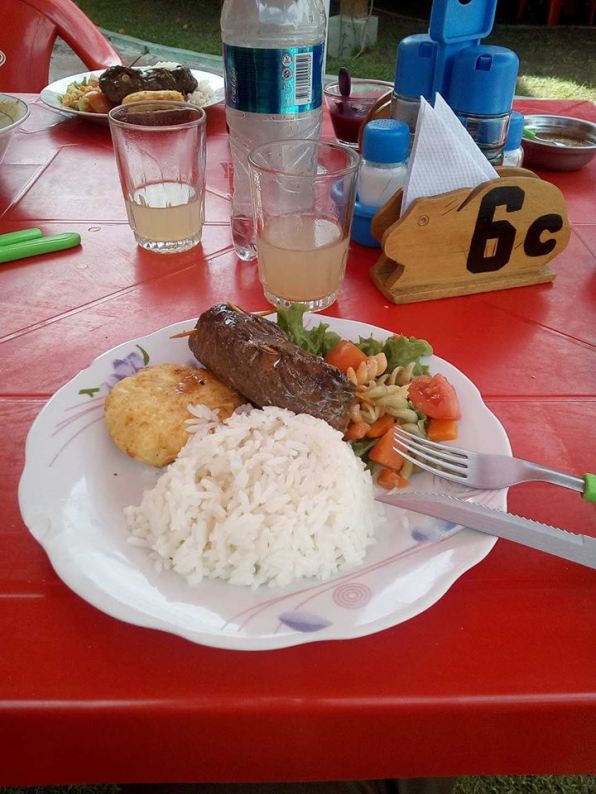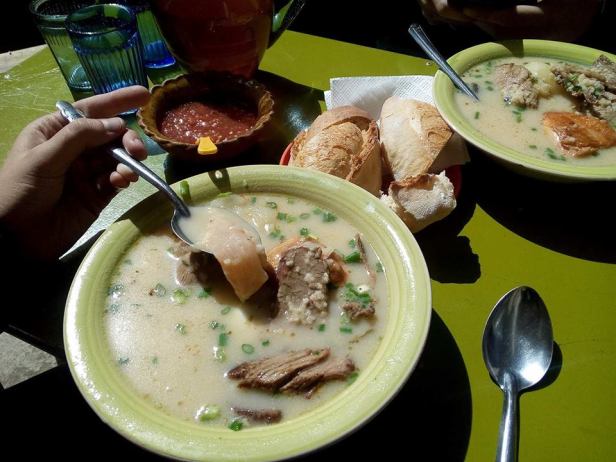Bolivia is one of the only countries in the world where McDonalds hasn’t (yet) settled its greasy, greedy claws into. Therefore, you can imagine that in La Paz I didn’t see any British or American food (even though I’m sure there are some around somewhere), only Bolivian. Even the English pub, called simply The English Pub, had traditional Bolivian dishes on the menu, as well as a Sunday Roast and Full English breakfast.

It is worth going to this pub because you’ll not only find some British people hanging around the bar or eating a plateful of bangers and mash, but the place is also full of Dutch, French, American and Spanish people, as well as many Bolivians who come to enjoy the company of these different types of people from around the globe while listening to some good old cheesy Anglophone music. The food is also fantastic, and even Bolivians would recommend eating some of their country’s finest dishes here. We had a pique macho to share – a plateful of different types of meat, veg, potatoes and egg drizzled in a sauce that I can only describe as the closest thing to gravy I’ve ever had outside of the UK. This was all washed down with my favourite Bolivian drink – Chuflay. A mixture of singani, which is a popular, sweet-tasting Bolivian spirit made from grapes, and either ginger beer or Sprite, Chuflay is the next rum and coke – simple, tasty, easy to make, cheap, and gets you drunk quickly if you drink more than three. However, if you’d prefer to stick to more world-renowned drinks, there are plenty of beers, simple cocktails, and rum and vodka mixtures on offer too.

Another bar worth popping into if you’re going to La Paz with a group of friends, or especially if you’re a solo traveller, is Loki. Situated on the top floor of a very tall building in the city’s centre, this bar actually belongs to the hostel of the same name, and so it is the perfect place to meet fellow backpackers from around the world, and you can even stay there during your time in La Paz. If you’re staying at a friend’s house, like I was, Loki makes for a fun night out dancing to good Anglophone and Hispanophone music, meeting new people, playing beer pong and pool, and of course, drinking the bar dry.

The next best drink after Chuflay, a non-alcoholic one this time, is Coca Tea. Coca Beer is also available in some bars and in street markets, and also look out for Lipeña – a beer made with quinoa, which is only found in the La Coca restaurant in the Sopocachi area, so be quick as it is very popular! These Coca drinks are made with real Coca leaves, which are actually what are used to make cocaine – after fermenting them and going through a very long and complicated process of course. I would definitely recommend chewing or drinking Coca leaves in La Paz, as they can help people to avoid or ease altitude sickness. However, they were interestingly originally used by miners who chewed the leaves to postpone hunger and sleepiness as they spent hours on hours undrground every day, without food. Today, the Aymara and Quechua people of Bolivia and Peru continue to chew, or suck, the leaves.

If you ever get the chance to go back to El Alto after only passing through it quickly from the airport, I would recommend that you do. The city actually has a bigger population than La Paz, at about one million, most being Aymara migrants from the surrounding altiplano, and at 4000m above sea level, you will be able to see incredible views of La Paz below you. Not only will you have the opportunity to ride one of the recently opened Telefericos (cable cars) and see the magnificent vistas on the way, but you will also get to explore the El Alto market – the biggest market in South America, which is held every Thursday and Sunday. Stretching for so many kilometres that even the locals get lost, here you can find everything from second-hand clothes and spare car parts to mobile phones and vintage watches. And of course, there are plenty of food stalls. Not far from the blue Teleferico station we had lunch from a stall managed by a traditionally-dressed woman – these women, who are proud to demonstrate their indigenous roots, are seen everywhere in the capital and are commonly known as Cholitas. The Cholita brought us bowls of caldo de cardan – a soup full of different types of meat and vegetables, which also includes an actual cow’s penis. Yes, I am not joking. If you want to tell friends that you have tasted penis soup then I urge you to try it! You don’t have to eat the slimy-looking lump, but it actually adds flavour to the broth! For a slightly less adventurous soup, look out for sopa de mani – a peanut broth also made with delicious vegetables.

For more ‘I’m A Celebrity Get Me Out Of Here’ esque foods, don’t be scared to try all the different kinds of food that are sold on the capital’s streets all day long. In the morning, opt for a yummy salteña or tucumana – pastry snacks not unlike Cornish pasties, full of meat, veg and scrumptious sauces. A chacha is also similar, but instead of normal cow meat or chicken, it is filled with llama meat. Before you turn your nose in disgust, llama meat actually tastes very similar to pulled pork, and even comes in a type of sweet barbecue sauce. Another dish for meat lovers is the anticucho – again sold on the street, and again more delicious than it sounds, the anticucho is in fact pieces of a cow’s heart, served with sauce and potatoes. However, for something a bit simpler and perhaps more similar to what you would eat at home, look out for choripan – available everywhere, as well being very popular in other South American countries also, a choripan is simply a slightly spicy sausage in a roll of bread, served with onions and sauce.

Bolivian dishes are normally very big but also very cheap, a three course lunch sometimes costing as little as 20 bolivianos, which would be the equivalent of about £2. In Mallasa, a village just five minutes’ bus journey from La Paz, we had an amazing lunch of spinach soup, followed by a good plateful of rice accompanied by salad, a hash brown type thing, and beef rolled in a way that made it look like a sausage, with vegetables inside. I love the way that they throw all kinds of food together, sometimes even serving potatoes, rice AND pasta all on the same plate. An example of this is the sajta and the silpancho. Sajta is a typical Bolivian dish of chicken served with rice, potatoes and a salad of peppers, onions, garlic and peanuts, drizzled with once again a slightly spicy but tasty sauce. The silpancho, my favourite dish and a perfect hangover cure thanks to the many yummy carbohydrates, is made up of multiple layers – at the bottom there are the potatoes, then rice, then lies the beef covered in breadcrumbs, then the fried egg, and finally, on the top, there is the colourful and crunchy tomato, red onion and green pepper salad.

I am literally salivating as I write this, and I hope you are too, because I guarantee you that you will not be disappointed by the food in La Paz. According to travel websites, backpackers overlook and forget about Bolivia when travelling around South America, which is unbelievable to me because I assure you that it is 100% worth visiting the country, as well as its beautiful capital – with an open mind, and an open mouth.
